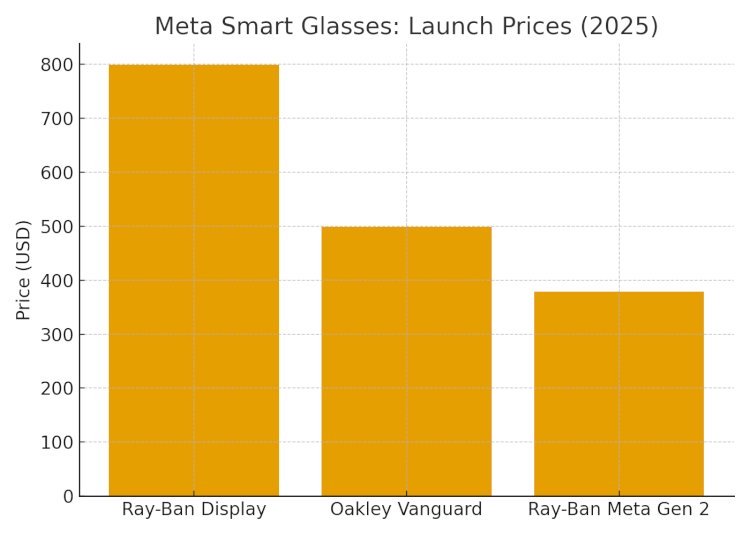Meta launches $799 Ray-Ban Display smart glasses with built-in screen
At Connect 2025, Meta launched $799 Ray-Ban Display smart glasses with built-in display, Neural Band control, and AI upgrades.

At Meta’s Connect 2025 conference, CEO Mark Zuckerberg unveiled the Ray-Ban Display smart glasses priced at $799 and launching September 30 in the United States. The device features a discreet full-color display for viewing messages, maps, and apps, controlled by a Neural Band wrist accessory that detects muscle activity through electromyography. Meta also updated its Ray-Ban Meta glasses with longer battery life, sharper video recording, and enhanced AI functions such as real-time translation, while introducing the rugged Oakley Meta Vanguard for athletes.
Zuckerberg said Meta’s aim is to make glasses that combine style with what he called “personal super intelligence.” He emphasized that the technology should remain in the background while helping people complete everyday tasks. “This isn’t about strapping a phone to your face. It’s about helping you quickly accomplish some of your everyday tasks without breaking your flow,” he told attendees.
The Ray-Ban Display keeps the familiar Wayfarer look but adds new hardware inside. The built-in display projects a full-color image in the right lens at 600×600 resolution with a 20-degree field of view, and brightness up to 5,000 nits. Only about 2% of the light leaks out, making it almost impossible for bystanders to see the screen, according to The Guardian’s hands-on report. The display is designed for short interactions and automatically switches off to avoid constant distraction.
The glasses weigh around 69 grams, making them heavier than standard sunglasses but lighter than VR headsets. Transition lenses adjust to ambient light, and the design includes overextension hinges for a better fit. A 12MP camera allows photos and 1080p video capture, while microphones and speakers enable calls and audio playback. Battery life is about six hours of mixed use, with a collapsible charging case providing several additional charges, as AP News noted.
Control comes from the new Meta Neural Band, worn like a wrist strap. It translates subtle wrist and finger movements into commands, allowing users to select apps, scroll, zoom, or adjust volume without cameras. Zuckerberg described it as a “scientific breakthrough” in natural interaction. The band lasts up to 18 hours on a charge and is water-resistant.
The Oakley Meta Vanguard, priced at $499, is aimed at athletes and outdoor users. It features rugged water-resistant frames, a centered 3K camera with stabilization, wide 122-degree field of view, and improved open-ear speakers. Meta has partnered with Garmin and Strava to let the glasses automatically capture training footage linked to workout stats. They will begin shipping October 21 in the U.S. and Canada, according to Reuters coverage.
Meta also refreshed its non-display Ray-Ban Meta Gen 2 line, starting at $379. These glasses double the battery life of the first generation and offer improved 3K video capture and sharper photos. They also integrate new AI features, including live translations and a “conversation focus” mode that amplifies a friend’s voice in noisy environments, as reported by AP News.
Live demos at Connect 2025 showed both strengths and weaknesses. Reviewers reported crisp visuals indoors and outdoors, accurate live captions, and smooth turn-by-turn navigation. Video calls through WhatsApp projected the caller into the lens while streaming the wearer’s point of view. However, the keynote also included glitches such as Wi-Fi interruptions and dropped calls, highlighting that first-generation display glasses still face reliability challenges. Business Insider noted that despite technical hiccups, the innovations were still praised as a major step forward.
Beyond hardware, Meta introduced new digital services at the event. The Horizon engine, designed for building 3D spaces, will now power more realistic environments. Horizon TV will offer content from Disney+, Hulu, and ESPN, while immersive horror films from Blumhouse and Universal Pictures will bring special effects directly into living rooms. Director James Cameron joined Zuckerberg on stage, describing how display advances could make 3D content as comfortable as cinema.
Availability for the Ray-Ban Display begins September 30 through U.S. retailers including Best Buy, LensCrafters, Ray-Ban stores, and Verizon. Expansion to Canada, France, Italy, and the UK is scheduled for early 2026.

The chart shows Meta’s fall 2025 lineup: the Ray-Ban Display at $799, the Oakley Vanguard at $499, and the updated Ray-Ban Meta Gen 2 at $379.
Privacy concerns remain. The glasses use visible indicators to show when recording, but critics argue these may not be enough. Earlier this year, TechCrunch highlighted that Meta had enabled AI voice features by default and retained recordings for up to a year. Regulators in Europe and Asia are expected to closely examine how the glasses handle data.
Despite those concerns, analysts view the Ray-Ban Display as the most advanced consumer smart glasses released to date. Accessibility advocates highlight benefits for the hard of hearing and visually impaired, while tech experts call it the closest realization yet of what Google Glass promised more than a decade ago. Whether they become a mainstream success or remain a luxury niche will depend on adoption, pricing, and how quickly Meta can build out useful software.




























